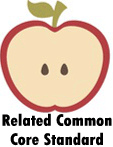Possessive Noun Worksheets
Related Standard: L.3.2.D

Nouns that indicate a sense of ownership are called possessives. They are denoted in writing, the singular form, by adding an apostrophe followed by the letter "s" at the end of the noun. When working with more than one (plural), you simply add the letter "s" to the end of the word. There is a difference between the use of possessives between American and British English. They each handle inanimate objects slightly differently. These worksheets follow the American English form and use for these parts of speech. Students will learn how to make word display and write providing a sense of ownership in the proper tense.
Possessive Noun Worksheets To Print:
That's Mine - Rewrite all these sentences properly. They all involve show sense of ownership that is lacking, even if it just over an apple.
Sentence Sum Up - Which item in there is yours? How can you restate these thoughts using a simple phrase?
Proper Checkmarks - This is like being a teacher that is grading a paper. Decide with all of these fit the bill.
Take Your Pick - Lines for writing are provided for your own sentences. You will write each sentence using the proper word form.
Full Rewrites - Write a complete thought that say who that thing belongs to.
Singular Forms - Complete each sentence by adding a word that demonstrates a sense of control. Add articles where needed.
Underlines - Rewrite the underlined nouns in the sentences below to make them possessive.
Writing with Them - A possessive noun shows ownership. Most of them are made by simply adding 's to them. Put them in action here.
Singular or Plural?
- Tell whether each underlined term or phrase is singular or plural. Write your answer on the line.
Complete the Sentence
- Complete each sentence. Write the form of the term in parentheses to show belonging.
Two Blanks - Read the two sentences. Then combine them by filling in the two blanks with the correct possessive noun and a common noun.
In Sentences - Write the correct form of word in the blanks to complete each sentence. These are more of an intermediate level.
How Does That Sound? - We get another round of practice in for you. Use your best judgement ot name the words or phrases that are asked of you.
Error Finder -
Find the error in each sentence. Write the correct form of the noun on the line.
What are Possessive Nouns?
Possessive noun, as the name suggests, is the noun that shows possession or ownership to someone. They are an important part of literature and one must know how and when to use them in writing as well as in spoken content. While reading, it is very easy to locate these terms as it always has an apostrophe. A possessive noun can either be used in singular or plural manner. Students must know where to use the singular form and where to use a plural form. You will find below is a detailed discussion about this very topic and how you can use it to improve your writing:
Singular Possessive Noun
As word singular itself means single, singular possessive nouns also show possession to a single person or object. Singular forms are made up of a single word and an apostrophe followed by s, to make a possessive singular noun you only have to add a 's at the end of any singular word. For example, "the dog's food finished" here the word dog is followed by an apostrophe which is making it a possessive singular noun and is showing the possession of food by a dog. Some other examples of singular forms are Kate's doll, James's car, etc.
Plural Possessive Nouns
These parts of speech are used to demonstrate a state or sense of possession to more than one object or human. There are two ways to make a plural possessive noun. First one is to add an apostrophe to the word that ends with letter s such as lakes', bikes' and second one is for words that do not end with letter s, in this case, add an apostrophe followed by letter s to make it a plural possessive noun, for example, men is a plural it does not end with letter s so to show possession to men we will write men's. Some other examples of plural forms are leaves', women's, mare's, etc.

